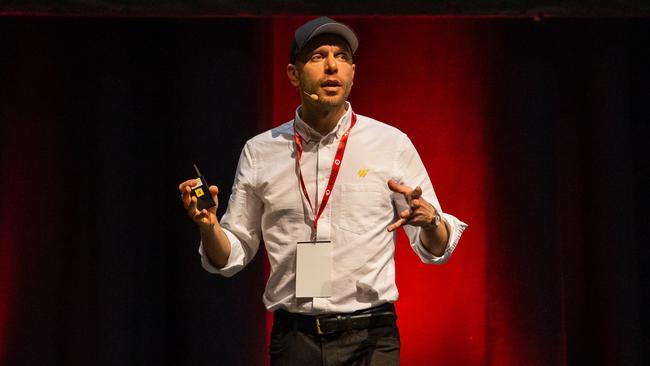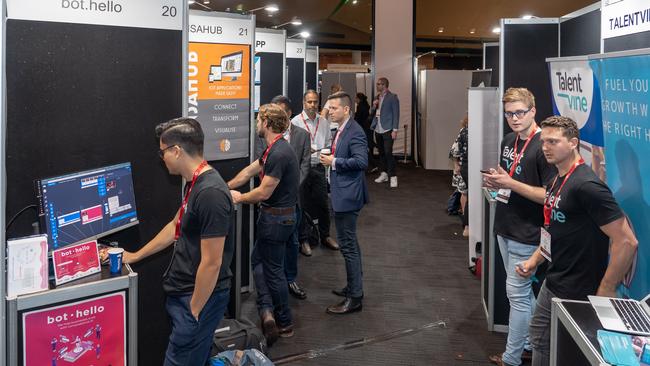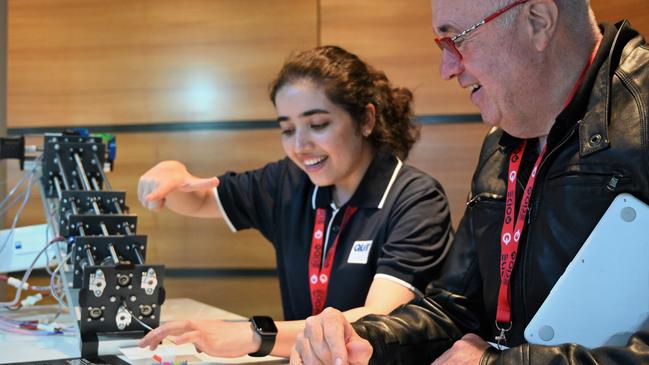Electric vehicles could kill the combustion engine
A German entrepreneur predicts the extinction of traditional fuel-powered cars as electric vehicles become cheaper.

The demise of the combustion engine could be under way in a decade as electric vehicles proliferate on our roads.
Many may disagree with the prediction of German entrepreneur Constantin Schwaab, the founder of Wirelane, which is developing charging stations for electric vehicles across Germany. The first was rolled out last year.
Schwaab was a speaker at QODE, a two-day convention held in Brisbane this week that examined the cutting edge of technology.
On stage, Schwaab demonstrated a “cobot”, a co-operative robot arm that can connect automatically to an electric vehicle’s refuelling point. In future, there won’t be any need to jump out of your car at a servo to load a fuel nozzle.
Schwaab says his views about the combustion engine were reinforced during a recent visit to Volkswagen’s headquarters in Wolfsburg, northern Germany. He says Volkswagen, whose factory is 8km long, has invested €45 million ($71m) in building a new factory for manufacturing EVs.

Schwaab says diesel is already dead in Europe as resale prices for diesel engines plummet. Next to go will be the combustion engine. “Very soon we will get to apply the inflection point where the electric vehicle will also be cheaper than the combustion engine vehicle,” he says, predicting this will happen in three years.
The conference outlined a future of on-demand car sharing rather than ownership. On-demand autonomous vehicles will cover 95 per cent of US passenger miles travelled by 2030.
Autonomous vehicle sales have risen by 64 per cent rise since 2017, and the choice of electric vehicles will have risen from eight models to 60 by next year.
Flying car technology will be here within 10 years, the conference was told. That may be so, but it is likely to take regulators years after that to work out arrangements enabling such vehicles to use airspace.

Queensland Innovations Minister Kate Jones says the state has supplied its “electric vehicle highway” with sufficient recharging stations to enable EVs to travel from Brisbane to Cairns. The Queensland government is investing in battery technology to reduce charging times.
Southeast Queensland’s trial of sensors got a decent airing, too. Brisbane City councillor Krista Adams says councils are already testing the adoption of the internet of things. Six gateways installed across Brisbane gather data from council barbecues and waterways. The council knows when its barbecues are damaged or need maintenance and cleaning. Waterways are being monitored for silt, rubbish and flow levels.
Councils in the southeast are trialling “smart poles”: electricity poles stacked with sensors and serving as Wi-Fi access points. Moves are afoot to ensure councils use compatible technology.

Michael Milford, chief investigator for the Australian Centre for Robotic Vision, says the centre is investigating how driverless transport interacts with existing road infrastructure, and roads adapted to autonomous use in Queensland.
The centre’s electric Renault ZOE is travelling 1200km around urban and rural streets day and night, under all weather conditions, collecting data on road usage. It is equipped with Lidar sensors, 360-degree cameras and precision GPS. “We’re trying to assess what changes may or may not be needed,” Milford says.
He says roads of the future may not require line markings: “It may or may not be a critical part of the autonomous driving cars. We drive on rural roads very well without line markings.”
Chris Lehnert, research affiliate at the centre, demonstrated a robot that autonomously detects and harvests capsicums.

The project is part of Queensland University of Technology’s involvement in a Future of Food Systems Co-operative Research Centre backed with $35 million in federal government funding, and in-kind funds from more than 50 participants.
“Robotics taking action, such as autonomous harvesting within indoor protected cropping, will be a game changer for growers who are struggling to reduce their production costs,” he says.
Chris Griffith travelled to Brisbane as a guest of QODE, part of Curiocity Brisbane by Tourism and Events Queensland and Brisbane Marketing.



To join the conversation, please log in. Don't have an account? Register
Join the conversation, you are commenting as Logout